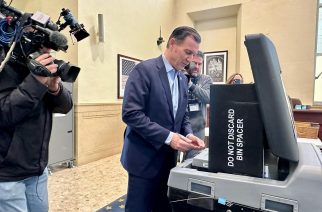
The balance in the Senate could be decided by a single race in next week’s special elections.
The race for Senate District 37 in Westchester — between Assemblywoman Shelley Mayer, D-Yonkers, and Republican candidate Julie Killian — is getting a lot of attention from the media, sitting legislators and state political committees, and turnout is expected to be heavy next Tuesday.
A second race in the Bronx is expected to go for the Democratic candidate. With a current split of 29 Democrats and 31 Republicans in the state Senate, following the dissolution of the Independent Democratic Conference, the results of two special elections in Senate Districts 32 and 37 could be the deciding factor in which party emerges with control of the Senate.
“There’s no modern history of divided control of the Senate,” said Gerald Benjamin, director of the Benjamin Center and a long-time political science professor at SUNY New Paltz. “In modern New York history there has always been a majority.”
The most recent voter enrollment statistics, released by the New York state Board of Elections earlier this month, show that District 37, located in Westchester County, has 80,021 active registered Democrats and 52,496 active registered Republicans. There are also 47,739 independent voters and the 3,312 active members of the Conservative Party, which has endorsed Killian.
According to a Siena Poll released April 17, of 692 registered voters surveyed, 57 percent of New Yorkers want a Democratic Senate in November while 33 percent want a Republican Senate.
“District 37 has always been a contested district,” said Blair Horner, executive director of New York Public Interest Research Group. “Regarding corruption, the challenger has an easier opportunity to make the case that Albany needs a change, since both parties have been playing a political blame game.”
Although Horner said he hoped to see an emphasis on anti-corruption during the campaign, a push for transparency is not the top issue for Westchester voters. For a more affluent suburban area such as Westchester, Horner says public safety, education and taxes are the “meat and potatoes” of the district.
“The fact that Democrats have county executives in Nassau, Suffolk and Westchester shows their message is more potent in suburbs,” Horner said. “It is clear to me that the battle for New York is one that is decided in the suburbs.”
Former Westchester Assemblyman Richard Brodsky said Republican voters in District 37 lack the enthusiasm and energy that Democratic voters have.
“The Republican Party is disappearing in New York,” said Brodsky, who teaches public policy at NYU and writes a column for the Albany Times Union. “The number of elected representatives has been down for 10 years because their policy point of view not supported by the majority of New Yorkers.”
Brodsky called the campaign an “extraneous national sideshow,” citing the typical political manner in which Killian and Mayer are running. “On the one hand, Killian is trying to attach Mayer to a scandal and [on the other] Mayer is trying to [attach] Killian to Trump,” Brodsky said. “For better or worse, I think Mayer is likely going to win, partially because she is talking about the important issues such as schools and hospitals.”

As an assemblywoman, Mayer has a record of voting in support of Democrat-led legislation such as the New York Safe Act. Mayer said she wants to end the Senate Republicans’ “years-long roadblock” on the Reproductive Health Act and the Child Victims Act. On the issue of school funding, Mayer has voted in support of securing funding for school construction and renovation during her tenure as assemblywoman, such as the $1.4 Million grant for the Empire State After-School Program. Mayer has also helped to secure $500,000 for classroom based artist residencies, through a grant to Arts Westchester which provided arts exposure for Yonkers students in twelve schools.
Though New Yorkers might be moving away from the Republican Party, candidates like Killian are representing a more progressive side of the GOP. Voicing her support for the Child Victims Act, environmental protection policies and “common sense” gun legislation — such as the establishment of extreme risk protection orders and increasing the age restrictions on gun purchases — Killian’s stances on policy deviate from the norm in New York’s Republican Senate.
This shift away from the Trump brand of Republicanism is one that Benjamin says is necessary for Republicans in New York to secure votes in the coming elections. “I think they have to, and it’s a test,” Benjamin said. “It’s a test for the statewide candidacy in the coming elections. It’s a canary in the coalmine.”
The District 37 race has drawn more attention and speculation than the race for Senate District 32, which is comprised of communities in the South Bronx. Democratic Assemblyman Luis Sepúlveda’s campaign is focused largely on criminal justice reform, housing affordability and funding for mental health research.

Pamela Stewart-Martinez, running on the Reform Party line, has pushed the importance of income equality, equitable education and affordable housing for residents of the South Bronx.
In an interview on BronxNet’s “In the District,” Republican candidate for District 32 Patrick Delices outlined a platform based on quality of life improvements for the South Bronx such as the cleanup of public parks and increased job opportunities in the district.
With 133,211 active registered Democrats and 6,241 active registered Republicans in District 32, it seems likely that Sepúlveda will win the seat.
Though the contest in District 37 is a crucial step in establishing a Democratic majority in the Senate, winning the support of Sen. Simcha Felder will ultimately be the deciding factor in who gains control of the state’s upper house.
“With Felder as the deciding factor of the Senate majority, he could become king,” Horner said. “Whatever he ends up doing will have different consequences.”
If Felder maintains his alliance with the Republicans, Horner said their margin of error will be narrowed down to zero, as they will not be able to rely on the IDC if needed. Additionally, Senator John DeFrancisco’s gubernatorial run complicates their majority.
However if Felder moves over to the Democrats, the leadership cannot be changed without a three-fifths vote, which they would not have with Felder. “He wants what’s best for his constituency,” Benjamin said. “It puts him in an extraordinarily powerful position. He might become extremely effective.”
Brodsky said he suspects that since the Democrats will do very well on a national level in November, with Democrats in New York enjoying the expected Blue wave, the potential “reign of Sen. Felder will be short lived.”









